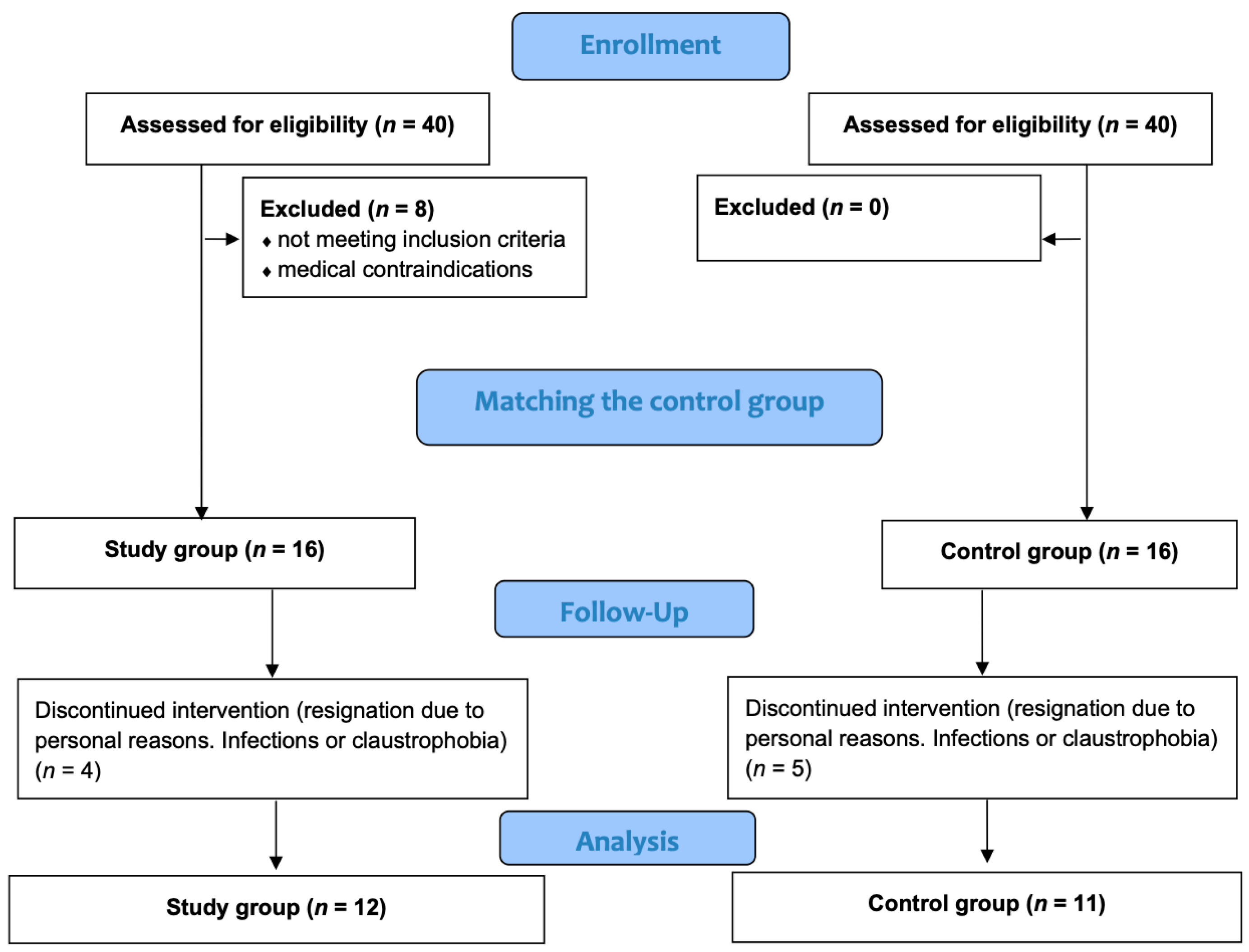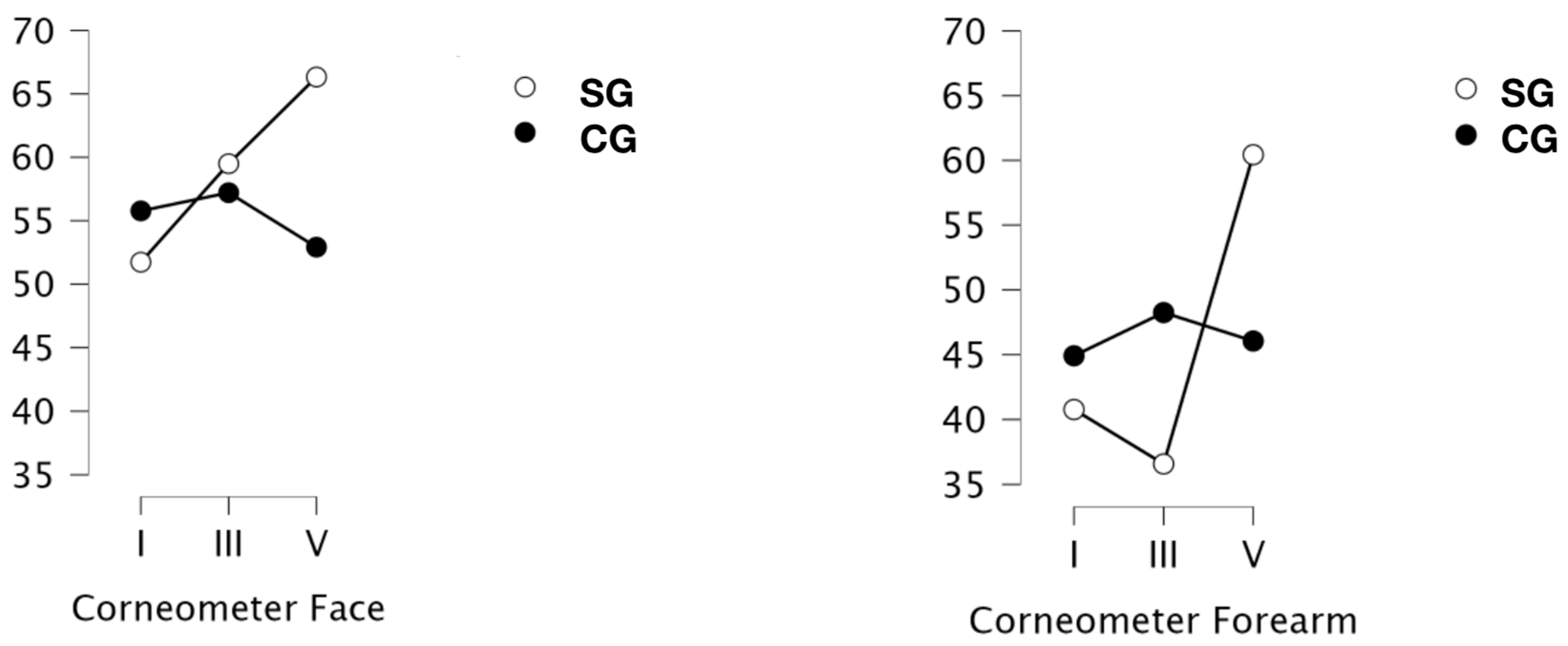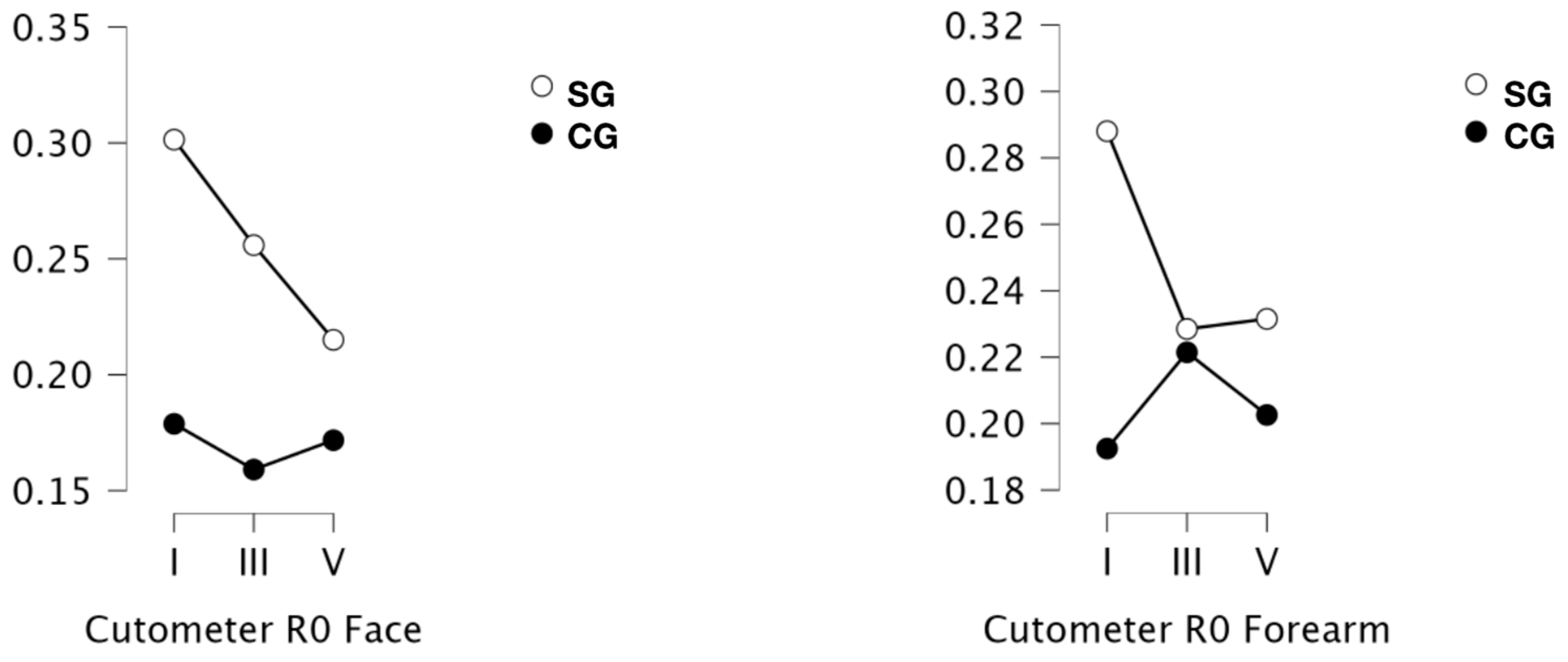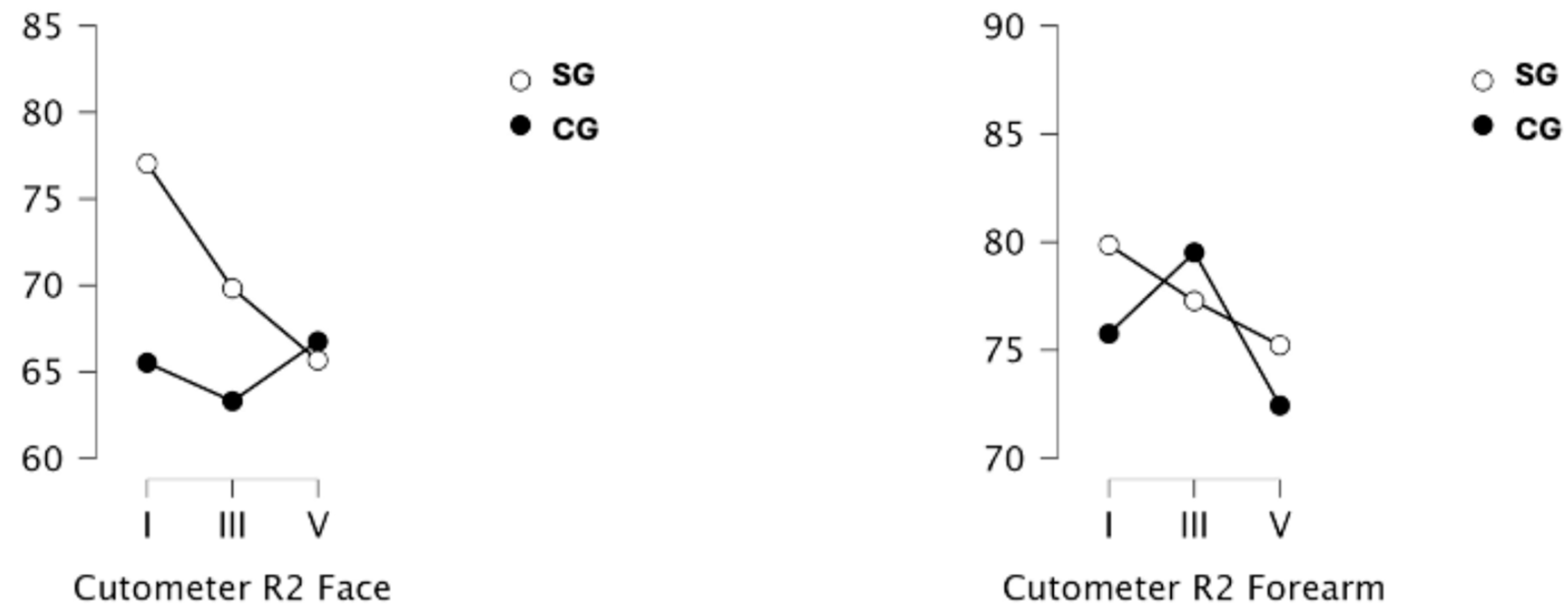Use of Measurement Probes to Evaluate the Effect of a Series of Whole-Body Cryostimulation Treatments on Skin Characteristics in Subjects with Different BMIs
Abstract
1. Introduction
2. Materials and Methods
2.1. Study Group
2.2. Study Protocol
2.3. Cyrotherapy
2.4. Anthropological Measurements
2.5. Skin Characteristic Measurements
2.6. Statistical Analysis
3. Results
3.1. Group and Baseline Skin Characteristics
3.2. Study of the Impact of Single Exposure WBC
3.3. Study of the Impact of Multiple Exposures WBC
3.4. Study of Impact of Series of WBC on Selected Skin Characteristics
3.5. Correlations
4. Discussion
Study Limitations
5. Conclusions
Author Contributions
Funding
Institutional Review Board Statement
Informed Consent Statement
Data Availability Statement
Acknowledgments
Conflicts of Interest
References
- Sieron, A.; Cieslar, G.; Stanek, A. Cryotherapy: Theoretical Bases, Biological Effects, Clinical; α-Medica Press: Bielsko-Biała, Poland, 2010. [Google Scholar]
- Legrand, F.D.; Dugué, B.; Costello, J.; Bleakley, C.; Miller, E.; Broatch, J.R.; Polidori, G.; Lubkowska, A.; Louis, J.; Lombardi, G.; et al. Evaluating Safety Risks of Whole-Body Cryotherapy/Cryostimulation (WBC): A Scoping Review from an International Consortium. Eur. J. Med. Res. 2023, 28, 387. [Google Scholar] [CrossRef] [PubMed]
- Sadura-Sieklucka, T.; Solłtysiuk, B.; Karlicka, A.; Sokolłowska, B.; Kontny, E.; Ksiezopolska-Orlłowska, K. Effects of Whole Body Cryotherapy in Patients with Rheumatoid Arthritis Considering Immune Parameters. Reumatologia 2019, 57, 320–325. [Google Scholar] [CrossRef] [PubMed]
- Dziedzic, A.; Maciak, K.; Miller, E.D.; Starosta, M.; Saluk, J. Targeting Vascular Impairment, Neuroinflammation, and Oxidative Stress Dynamics with Whole-Body Cryotherapy in Multiple Sclerosis Treatment. Int. J. Mol. Sci. 2024, 25, 3858. [Google Scholar] [CrossRef] [PubMed]
- Klemm, P.; Becker, J.; Aykara, I.; Asendorf, T.; Dischereit, G.; Neumann, E.; Müller-Ladner, U.; Lange, U. Serial Whole-Body Cryotherapy in Fibromyalgia Is Effective and Alters Cytokine Profiles. Adv. Rheumatol. 2021, 61, 3. [Google Scholar] [CrossRef]
- Wiecek, M.; Szymura, J.; Sproull, J.; Szygula, Z. Whole-Body Cryotherapy Is an Effective Method of Reducing Abdominal Obesity in Menopausal Women with Metabolic Syndrome. J. Clin. Med. 2020, 9, 2797. [Google Scholar] [CrossRef]
- Rymaszewska, J.E.; Stańczykiewicz, B.; Lion, K.; Misiak, B. The Impact of Whole-Body Cryotherapy on Lipid Profile: A Systematic Review and Meta-Analysis. Complement. Ther. Med. 2020, 55, 102568. [Google Scholar] [CrossRef]
- Fontana, J.M.; Bozgeyik, S.; Gobbi, M.; Piterà, P.; Giusti, E.M.; Dugué, B.; Lombardi, G.; Capodaglio, P. Whole-Body Cryostimulation in Obesity. A Scoping Review. J. Therm. Biol. 2022, 106, 103250. [Google Scholar] [CrossRef]
- Bouzigon, R.; Grappe, F.; Ravier, G.; Dugue, B. Whole-and Partial-Body Cryostimulation/Cryotherapy: Current Technologies and Practical Applications. J. Therm. Biol. 2016, 61, 67–81. [Google Scholar] [CrossRef]
- Schaal, K.; Le Meur, Y.; Louis, J.; Filliard, J.R.; Hellard, P.; Casazza, G.; Hausswirth, C. Whole-Body Cryostimulation Limits Overreaching in Elite Synchronized Swimmers. Med. Sci. Sports Exerc. 2015, 47, 1416–1425. [Google Scholar] [CrossRef]
- Rymaszewska, J.; Ramsey, D. Whole Body Cryotherapy as a Novel Adjuvant Therapy for Depression and Anxiety. Arch. Psychiatry Psychother. 2008, 2, 49–57. [Google Scholar]
- Dzidek, A.; Piotrowska, A. The Use of Cryotherapy in Cosmetology and the Influence of Cryogenic Temperatures on Selected Skin Parameters—A Review of the Literature. Cosmetics 2022, 9, 100. [Google Scholar] [CrossRef]
- Piotrowska, A.; Aszklar, K.; Dzidek, A.; Ptaszek, B.; Czerwińska-Ledwig, O.; Pilch, W. The Impact of a Single Whole Body Cryostimulation Treatment on Selected Skin Properties of Healthy Young Subjects. Cryobiology 2021, 100, 96–100. [Google Scholar] [CrossRef] [PubMed]
- Rho, N.K. Revisiting the Role of Local Cryotherapy for Acne Treatment: A Review and Update. J. Clin. Med. 2023, 12, 26. [Google Scholar] [CrossRef] [PubMed]
- Sybilski, A. Skin—The Most Important Organ of Our Body. Let’s Take Care of It! Pediatr. Med. Rodz. 2012, 8, 375–379. [Google Scholar]
- Harris-Tryon, T.; Grice, E. Microbiota and Maintenance of Skin Barrier Function. Science 2022, 376, 940–945. [Google Scholar] [CrossRef]
- Alexander, H.; Brown, S.; Danby, S.; Flohr, C. Research Techniques Made Simple: Transepidermal Water Loss Measurement as a Research Tool. J. Investig. Dermatol. 2018, 138, 2295–2300.e1. [Google Scholar] [CrossRef]
- Lubkowska, A. Therapeutic Application of Cryotherapy in Chronic Diseases-Clinical Practice. Fam. Med. Prim. Care Rev. 2013, 15, 233–239. [Google Scholar]
- Castellani, J.W.; Young, A.J. Human Physiological Responses to Cold Exposure: Acute Responses and Acclimatization to Prolonged Exposure. Auton. Neurosci. 2016, 196, 63–74. [Google Scholar] [CrossRef]
- Pilch, W.; Piotrowska, A.; Wyrostek, J.; Czerwińska-Ledwig, O.; Ziemann, E.; Antosiewicz, J.; Zasada, M.; Kulesa-Mrowiecka, M.; Żychowska, M. Different Changes in Adipokines, Lipid Profile, and TNF-Alpha Levels between 10 and 20 Whole Body Cryostimulation Sessions in Individuals with I and II Degrees of Obesity. Biomedicines 2022, 10, 269. [Google Scholar] [CrossRef]
- Hirt, P.A.; Castillo, D.E.; Yosipovitch, G.; Keri, J.E. Skin Changes in the Obese Patient. J. Am. Acad. Dermatol. 2019, 81, 1037–1057. [Google Scholar] [CrossRef]
- Yew, Y.W.; Mina, T.; Ng, H.K.; Lam, B.C.C.; Riboli, E.; Lee, E.S.; Lee, J.; Ngeow, J.; Elliott, P.; Thng, S.T.G.; et al. Investigating Causal Relationships between Obesity and Skin Barrier Function in a Multi-Ethnic Asian General Population Cohort. Int. J. Obes. 2023, 47, 963–969. [Google Scholar] [CrossRef] [PubMed]
- Guo, Z.; Yang, Y.; Liao, Y.; Shi, Y.; Zhang, L. Emerging Roles of Adipose Tissue in the Pathogenesis of Psoriasis and Atopic Dermatitis in Obesity. JID Innov. 2022, 2, 100064. [Google Scholar] [CrossRef]
- Skrzek, A.; Ciszek, A.; Nowicka, D.; Dębiec-Bąk, A. Evaluation of Changes in Selected Skin Parameters under the Influence of Extremely Low Temperature. Cryobiology 2019, 86, 19–24. [Google Scholar] [CrossRef]
- Weir, C.; Jan, A. BMI Classificatioon Percentile and Cut Off Points; StatPearls Publishing: Treasure Island, FL, USA, 2023. [Google Scholar]
- O’Connor, M.; Wang, J.V.; Saedi, N. Whole-and Partial-Body Cryotherapy in Aesthetic Dermatology: Evaluating a Trendy Treatment. J. Cosmet. Dermatol. 2019, 18, 1435–1437. [Google Scholar] [CrossRef]
- Wojciak, G.; Szymura, J.; Szygula, Z.; Gradek, J.; Wiecek, M. The Effect of Repeated Whole-Body Cryotherapy on SIRT1 and SIRT3 Concentrations and Oxidative Status in Older and Young Men Performing Different Levels of Physical Activity. Antioxidants 2021, 10, 37. [Google Scholar] [CrossRef] [PubMed]
- Miller, E.; Mrowicka, M.; Malinowska, K.; Mrowicki, J.; Saluk-Juszczak, J.; Kȩdziora, J. Effects of Whole-Body Cryotherapy on a Total Antioxidative Status and Activities of Antioxidative Enzymes in Blood of Depressive Multiple Sclerosis Patients. World J. Biol. Psychiatry 2011, 12, 223–227. [Google Scholar] [CrossRef]
- Herrera, E.; Sandoval, M.C.; Camargo, D.M.; Salvini, T.F. Motor and Sensory Nerve Conduction Are Affected Differently by Ice Pack, Ice Massage, and Cold Water Immersion. Phys. Ther. 2010, 90, 581–591. [Google Scholar] [CrossRef]
- Treffel, P.; Panisset, F.; Faivre, B.; Agache, P. Hydration, transepidermal water loss, pH and skin surface parameters: Correlations and variations between dominant and non-dominant forearms. Br. J. Dermatol. 1994, 130, 325–328. [Google Scholar] [CrossRef] [PubMed]
- Enright, K.M.; Nikolis, A. In vivo determination of the skin surface topography and biophysical properties of human hands: Effects of sex and hand dominance. Ski. Res. Technol. 2020, 26, 277–283. [Google Scholar] [CrossRef]
- Piotrowska, A.; Czerwińska-Ledwig, O.; Kotarba, P. Selected hand skin characteristics of laboratory diagnosticians. Med. Pr. Work. Health Saf. 2020, 71, 725–734. [Google Scholar] [CrossRef]
- Szymoniak-Lipska, M.; Dańczak-Pazdrowska, A.; Lipski, A.; Korecka, K.; Żaba, R.; Polańska, A. Transepidermal water loss (TEWL) and transonychial water loss (TOWL) measurements in healthy nail apparatus. Ski. Res. Technol. 2024, 30, e13851. [Google Scholar] [CrossRef]
- Cholewka, A.; Stanek, A.; Sieroń, A.; Drzazga, Z. Thermography Study of Skin Response Due to Whole-Body Cryotherapy. Ski. Res. Technol. 2012, 18, 180–187. [Google Scholar] [CrossRef]
- de Farias Pires, T.; Azambuja, A.P.; Vançan Russo Horimoto, A.R.; Nakamura, M.S.; de Oliveira Alvim, R.; Krieger, J.E.; Pereira, A.C. A Population-Based Study of the Stratum Corneum Moisture. Clin. Cosmet. Investig. Dermatol. 2016, 9, 79–87. [Google Scholar] [CrossRef] [PubMed][Green Version]
- Ma, L.; Zhang, H.; Jia, Q.; Bai, T.; Yang, S.; Wang, M.; Li, Y.; Shao, L. Facial Physiological Characteristics and Skin Microbiomes Changes Are Associated with Body Mass Index (BMI). Clin. Cosmet. Investig. Dermatol. 2024, 17, 513–528. [Google Scholar] [CrossRef]
- Yang, B.; Lai, Q.; Chen, A.; Ye, L.; Wang, X.; Lai, Y.; Liu, D.; Man, M.Q. Body Mass Index z Scores Correlate with Epidermal Function in Chinese Children. Diabetes Metab. Syndr. Obes. 2023, 16, 3393–3401. [Google Scholar] [CrossRef]
- Guida, B.; Nino, M.; Perrino, N.R.; Laccetti, R.; Trio, R.; Labella, S.; Balato, N. The Impact of Obesity on Skin Disease and Epidermal Permeability Barrier Status. J. Eur. Acad. Dermatol. Venereol. 2010, 24, 191–195. [Google Scholar] [CrossRef]
- Yosipovitch, G.; DeVore, A.; Dawn, A. Obesity and the Skin: Skin Physiology and Skin Manifestations of Obesity. J. Am. Acad. Dermatol. 2007, 56, 901–916. [Google Scholar] [CrossRef] [PubMed]
- Proksch, E. PH in Nature, Humans and Skin. J. Dermatol. 2018, 45, 1044–1052. [Google Scholar] [CrossRef]
- Hachem, J.P.; Crumrine, D.; Fluhr, J.; Brown, B.E.; Feingold, K.R.; Elias, P.M. PH Directly Regulates Epidermal Permeability Barrier Homeostasis, and Stratum Corneum Integrity/Cohesion. J. Investig. Dermatol. 2003, 121, 345–353. [Google Scholar] [CrossRef]
- Smythe, P.; Wilkinson, H.N. The Skin Microbiome: Current Landscape and Future Opportunities. Int. J. Mol. Sci. 2023, 24, 3950. [Google Scholar] [CrossRef]
- Yew, Y.; Thing, T.; Chambers, J.; Chian, L. Relationship of Adiposity and Skin Epidermal Barrier Status: Results from an Asian General Population Cohort Study. J. Am. Acad. Dermatol. 2019, 81, AB117. [Google Scholar]
- Ibuki, A.; Kuriyama, S.; Toyosaki, Y.; Aiba, M.; Hidaka, M.; Horie, Y.; Fujimoto, C.; Isami, F.; Shibata, E.; Terauchi, Y.; et al. Aging-like Physiological Changes in the Skin of Japanese Obese Diabetic Patients. SAGE Open Med. 2018, 6, 1–6. [Google Scholar] [CrossRef]
- Misiorek, A.; Szyszkowska Kępińska, M. Evaluation of the Influence of Whole-Body Cryotherapy on Selected Skin Parameters in Healthy Individuals: Pilot Study. Cryobiology 2021, 100, 77–80. [Google Scholar] [CrossRef]
- Du Plessis, J.L.; Stefaniak, A.B.; Wilhelm, K.P. Measurement of Skin Surface PH. Curr. Probl. Dermatol. 2018, 54, 19–25. [Google Scholar] [CrossRef]
- Liu, M.; Feng, J. Association between Adiposity and Facial Aging: Results from a Mendelian Randomization Study. Eur. J. Med. Res. 2023, 28, 350. [Google Scholar] [CrossRef]
- Santos, A.L.; Sinha, S. Obesity and Aging: Molecular Mechanisms and Therapeutic Approaches. Ageing Res. Rev. 2021, 67, 101268. [Google Scholar] [CrossRef]
- Kruglikov, I.L.; Scherer, P.E. Skin Aging: Are Adipocytes the next Target? Aging 2016, 8, 1457–1469. [Google Scholar] [CrossRef]
- Enser, M.; Avery, N.C. Mechanical and Chemical Properties of the Skin and Its Collagen from Lean and Obese-Hyperglycaemic (Ob/Ob) Mice. Diabetologia 1984, 27, 44–49. [Google Scholar] [CrossRef]
- Walker, J.M.; Garcet, S.; Aleman, J.O.; Mason, C.E.; Danko, D.; Zuffa, S.; Swann, J.R.; Krueger, J.; Breslow, J.L.; Holt, P.R. Obesity and Ethnicity Alter Gene Expression in Skin. Sci. Rep. 2020, 10, 14079. [Google Scholar] [CrossRef] [PubMed]
- Sorop, O.; Olver, D.; Van De Wouw, J.; Heinonen, I.; Van Duin, R.W.; Duncker, D.J.; Merkus, D. The Microcirculation: A Key Player in Obesity-Associated Cardiovascular Disease. Cardiovasc. Res. 2017, 113, 1035–1045. [Google Scholar] [CrossRef] [PubMed]
- Pilch, W.; Wyrostek, J.; Major, P.; Zuziak, R.; Piotrowska, A.; Czerwińska-Ledwig, O.; Grzybkowska, A.; Zasada, M.; Ziemann, E.; Żychowska, M. The Effect of Whole-Body Cryostimulation on Body Composition and Leukocyte Expression of HSPA1A, HSPB1, and CRP in Obese Men. Cryobiology 2020, 94, 100–106. [Google Scholar] [CrossRef]
- Loap, S.; Lathe, R. Mechanism Underlying Tissue Cryotherapy to Combat Obesity/Overweight: Triggering Thermogenesis. J. Obes. 2018, 2018, 5789647. [Google Scholar] [CrossRef]
- Lubkowska, A.; Dudzińska, W.; Bryczkowska, I.; Dołęgowska, B. Body Composition, Lipid Profile, Adipokine Concentration, and Antioxidant Capacity Changes during Interventions to Treat Overweight with Exercise Programme and Whole-Body Cryostimulation. Oxid. Med. Cell. Longev. 2015, 2015, 803197. [Google Scholar] [CrossRef]
- Ziemann, E.; Olek, R.A.; Grzywacz, T.; Antosiewicz, J.; Kujach, S.; Łuszczyk, M.; Smaruj, M.; Śledziewska, E.; Laskowski, R. Whole-Body Cryostimulation as an Effective Method of Reducing Low-Grade Inflammation in Obese Men. J. Physiol. Sci. 2013, 63, 333–343. [Google Scholar] [CrossRef]







| SG | CG | p SG vs. CG | |||
|---|---|---|---|---|---|
| SD | SD | ||||
| Age [years] | 43.92 | 13.08 | 43.55 | 11.5 | 0.989 |
| Weight [kg] | 92.7 | 12.96 | 69.13 | 10.34 | 0.006 |
| Height [cm] | 171.67 | 8.34 | 171.36 | 8.65 | 0.839 |
| BMI [kg/m2] | 31.34 | 2.57 | 23.47 | 2.29 | <0.001 |
| Face | |||||||||||
| Study Group | Control Group | p SG vs. CG | |||||||||
| SD | Med | Min | Max | SD | Med | Min | Max | ||||
| Hydration [IU] | 51.73 | 13.12 | 52.30 | 26.07 | 72.93 | 55.77 | 8.91 | 55.53 | 42.47 | 68.93 | 0.185 |
| TEWL [g/m2/h] | 20.28 | 3.42 | 19.42 | 15.81 | 27.12 | 10.94 | 3.50 | 10.50 | 5.80 | 16.80 | <0.001 |
| pH | 4.89 | 0.55 | 4.83 | 4.05 | 6.02 | 4.81 | 0.78 | 5.00 | 3.47 | 5.85 | 0.715 |
| R0 | 0.30 | 0.06 | 0.33 | 0.21 | 0.38 | 0.18 | 0.03 | 0.18 | 0.13 | 0.23 | <0.001 |
| R2 | 77.04 | 13.96 | 77.69 | 51.63 | 96.90 | 65.52 | 10.52 | 66.77 | 53.63 | 85.93 | 0.061 |
| Forearm | |||||||||||
| Study group | Control group | p SG vs. CG | |||||||||
| SD | Med | Min | Max | SD | Med | Min | Max | ||||
| Hydration [IU] | 40.77 | 8.84 | 38.45 | 30.40 | 57.53 | 44.91 | 6.92 | 45.90 | 35.20 | 55.70 | 0.074 |
| TEWL [g/m2/h] | 20.74 | 12.26 | 15.71 | 9.54 | 42.64 | 12.94 | 5.79 | 11.10 | 7.06 | 25.90 | 0.111 |
| pH | 4.98 | 0.74 | 4.64 | 4.19 | 6.66 | 4.67 | 0.73 | 4.67 | 3.76 | 5.84 | 0.273 |
| R0 | 0.29 | 0.04 | 0.29 | 0.22 | 0.35 | 0.19 | 0.02 | 0.19 | 0.17 | 0.22 | <0.001 |
| R2 | 79.86 | 6.77 | 81.30 | 69.33 | 90.17 | 75.76 | 6.97 | 77.37 | 64.47 | 83.67 | 0.369 |
| SG | CG | ||||||
|---|---|---|---|---|---|---|---|
| I vs. II | III vs. IV | V vs. VI | I vs. II | III vs. IV | V vs. VI | ||
| Hydration [IU] | Face | 0.080 | 0.089 | 0.167 | 0.511 | 0.103 | 0.561 |
| Forearm | 0.332 | 0.850 | 0.117 | 0.020 * | 0.328 | 0.156 | |
| TEWL [g/m2/h] | Face | 0.482 | 0.141 | 0.089 | 0.291 | 0.061 | 0.082 |
| Forearm | 0.710 | 0.045 * | 0.030 * | 0.341 | 0.290 | 0.128 | |
| pH | Face | 0.595 | 0.594 | 0.339 | 0.093 | 0.231 | 0.445 |
| Forearm | 0.818 | 0.562 | 0.215 | 0.274 | 0.341 | 0.220 | |
| R0 | Face | 0.381 | 0.072 | 0.468 | 0.424 | 0.422 | 0.260 |
| Forearm | 0.452 | 0.422 | 0.921 | 0.701 | 0.091 | 0.109 | |
| R2 | Face | 0.243 | 0.802 | 0.352 | 0.095 | 0.562 | 0.493 |
| Forearm | 0.381 | 0.588 | 0.054 | 0.399 | 0.062 | 0.025 * | |
| SG | CG | ||||||||||||||
|---|---|---|---|---|---|---|---|---|---|---|---|---|---|---|---|
| Δ1 | Δ10 | Δ20 | Δ1 | Δ10 | Δ20 | ||||||||||
| SD | SD | SD | p | SD | SD | SD | p | ||||||||
| Hydration [IU] | Face | 7.13 | 7.03 | 9.69 | 10.88 | 7.77 | 7.19 | 0.623 | 7.99 | 8.09 | 6.23 | 6.19 | 6.54 | 7.79 | 0.873 |
| Forearm | 7.58 | 7.76 | 6.11 | 5.46 | 12.49 | 8.76 | 0.078 | 4.26 | 3.13 | 8.93 | 8.74 | 6.47 | 8.22 | 0.275 | |
| TEWL [g/m2/h] | Face | 5.08 | 3.6 | 2.59 | 1.96 | 10.25 | 15.06 | 0.172 | 3.20 | 2.70 | 9.24 | 7.94 | 6.78 | 7.70 | 0.105 |
| Forearm | 16.96 | 20.33 | 3.41 | 5.48 | 17.99 | 12.87 | 0.046 * | 4.77 | 4.15 | 17.73 | 14.97 | 11.91 | 15.91 | 0.144 | |
| pH | Face | 0.74 | 0.74 | 0.52 | 0.46 | 0.71 | 0.4 | 0.614 | 0.7 | 0.48 | 0.47 | 0.29 | 0.54 | 0.57 | 0.484 |
| Forearm | 0.74 | 0.81 | 0.63 | 0.70 | 0.8 | 0.75 | 0.857 | 0.69 | 0.6 | 0.34 | 0.29 | 0.45 | 0.43 | 0.212 | |
| R0 | Face | 0.30 | 0.88 | 0.04 | 0.05 | 0.05 | 0.09 | 0.913 | 0.02 | 0.01 | 0.02 | 0.02 | 0.02 | 0.01 | 0.337 |
| Forearm | 0.03 | 0.03 | 0.30 | 0.86 | 0.02 | 0.02 | 0.094 | 0.02 | 0.02 | 0.04 | 0.03 | 0.02 | 0.01 | 0.009 * | |
| R2 | Face | 15.16 | 15.92 | 7.81 | 4.38 | 14.35 | 18.76 | 0.779 | 3.81 | 2.69 | 4.54 | 3.08 | 3.58 | 3.72 | 0.463 |
| Forearm | 7.54 | 5.58 | 8.20 | 5.04 | 11.13 | 8.54 | 0.401 | 4.32 | 3.45 | 11.02 | 9.71 | 5.58 | 5.42 | 0.529 | |
| Spearman’s rho | p | ||
|---|---|---|---|
| Hydration face | Hydration forearm | 0.749 | <0.001 * |
| TEWL face | TEWL forearm | 0.453 | 0.031 * |
| pH Face | pH forearm | 0.868 | <0.001 * |
| R0 face | R0 forearm | 0.793 | <0.001 * |
| Hydration forearm | R0 forearm | −0.474 | 0.022 * |
| TEWL forearm | R0 forearm | 0.409 | 0.054 |
| TEWL face | R0 face | 0.653 | <0.001 * |
| TEWL face | R2 face | 0.492 | 0.017 * |
| TEWL face | BMI | 0.758 | <0.001 * |
| R0 face | BMI | 0.675 | <0.001 * |
| R0 forearm | BMI | 0.714 | <0.001 * |
Disclaimer/Publisher’s Note: The statements, opinions and data contained in all publications are solely those of the individual author(s) and contributor(s) and not of MDPI and/or the editor(s). MDPI and/or the editor(s) disclaim responsibility for any injury to people or property resulting from any ideas, methods, instructions or products referred to in the content. |
© 2025 by the authors. Licensee MDPI, Basel, Switzerland. This article is an open access article distributed under the terms and conditions of the Creative Commons Attribution (CC BY) license (https://creativecommons.org/licenses/by/4.0/).
Share and Cite
Dzidek, A.; Czerwińska-Ledwig, O.; Szlachetka, A.; Ziemann, E.; Kasprzak, D.; Zasada, M.; Piotrowska, A. Use of Measurement Probes to Evaluate the Effect of a Series of Whole-Body Cryostimulation Treatments on Skin Characteristics in Subjects with Different BMIs. Appl. Sci. 2025, 15, 2897. https://doi.org/10.3390/app15062897
Dzidek A, Czerwińska-Ledwig O, Szlachetka A, Ziemann E, Kasprzak D, Zasada M, Piotrowska A. Use of Measurement Probes to Evaluate the Effect of a Series of Whole-Body Cryostimulation Treatments on Skin Characteristics in Subjects with Different BMIs. Applied Sciences. 2025; 15(6):2897. https://doi.org/10.3390/app15062897
Chicago/Turabian StyleDzidek, Adrianna, Olga Czerwińska-Ledwig, Agata Szlachetka, Ewa Ziemann, Dorota Kasprzak, Mariusz Zasada, and Anna Piotrowska. 2025. "Use of Measurement Probes to Evaluate the Effect of a Series of Whole-Body Cryostimulation Treatments on Skin Characteristics in Subjects with Different BMIs" Applied Sciences 15, no. 6: 2897. https://doi.org/10.3390/app15062897
APA StyleDzidek, A., Czerwińska-Ledwig, O., Szlachetka, A., Ziemann, E., Kasprzak, D., Zasada, M., & Piotrowska, A. (2025). Use of Measurement Probes to Evaluate the Effect of a Series of Whole-Body Cryostimulation Treatments on Skin Characteristics in Subjects with Different BMIs. Applied Sciences, 15(6), 2897. https://doi.org/10.3390/app15062897







